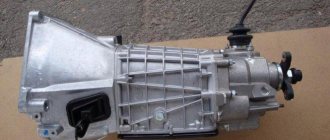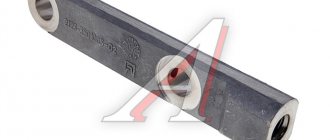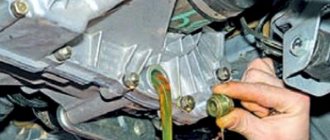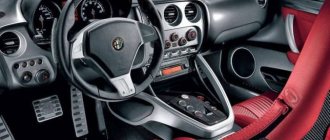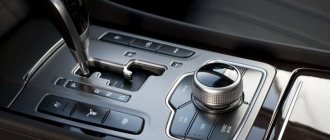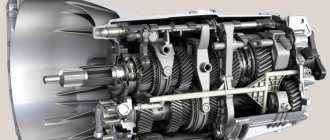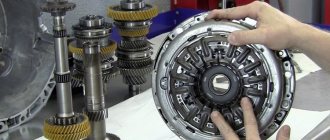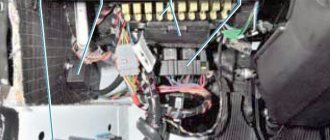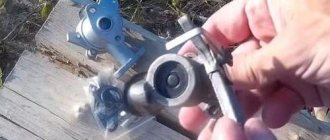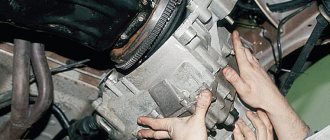The Niva car is positioned as an SUV that has increased cross-country ability. Due to this, there is a demand for the car. A durable load-bearing body has been installed. The Niva 2131 model is built on the basis of the LADA 4×4. Its tuning allows you to change the exterior and performance characteristics for the better. Since the mid-1990s. Injection engines have become available for Niva cars.
In addition to passenger cars, self-propelled vehicles are also produced under the Niva brand. In particular, this is Niva SK 5. This vehicle is a combine harvester designed for harvesting crops. The machine runs on diesel fuel.
Gear shift mechanism VAZ 2121
The Niva car is positioned as an SUV that has increased cross-country ability. Due to this, there is a demand for the car. A durable load-bearing body has been installed. The Niva 2131 model is built on the basis of the LADA 4×4. Its tuning allows you to change the exterior and performance characteristics for the better. Since the mid-1990s. Injection engines have become available for Niva cars.
In addition to passenger cars, self-propelled vehicles are also produced under the Niva brand. In particular, this is Niva SK 5. This vehicle is a combine harvester designed for harvesting crops. The machine runs on diesel fuel.
The body parts of the VAZ-21213 Lada Niva and VAZ-21214 Lada 4x4 gearboxes, the clutch housing, the gearbox housing itself and the rear cover are cast from aluminum alloy and tightened together with studs and nuts. The connections are sealed with cardboard gaskets. When repairing, you can use sealant. To improve heat dissipation, the surface of the gearbox housing has fins.
The bottom of the crankcase is closed with a stamped steel cover with a gasket (fastening with studs). The clutch housing is bolted to the engine cylinder block. To ensure alignment between the engine crankshaft and the gearbox input shaft, the crankcase is centered on two bushings. There are grooves for them in the mounting holes of the block and crankcase.
The third support of the power unit is installed on the rear cover of the gearbox. It is attached to the cross member, which in turn is attached to the body floor (with welded bolts). There is a filler (control) hole in the gearbox housing on the left side, and a drain hole in the lower crankcase cover. The holes are closed with plugs with conical threads.
There is a magnet in the drain plug. It traps steel particles that enter the oil when parts wear. A breather is screwed into the upper part of the clutch housing. It prevents the pressure in the gearbox from increasing when it heats up. If the breather malfunctions (jamming of the cap), severe oil leakage through the seals is possible.
Design of a five-speed gearbox for VAZ-21213 Lada Niva and VAZ-21214 Lada 4x4.
The front part of the five-speed gearbox of the VAZ-21213 Lada Niva and VAZ-21214 Lada 4x4.
Diagram of operation and gearing of the five-speed gearbox VAZ-21213 Lada Niva and VAZ-21214 Lada 4x4.
Names and catalog numbers of parts of the five-speed gearbox VAZ-21213 Lada Niva and VAZ-21214 Lada 4x4.
Gear ratios of the five-speed gearbox VAZ-21213 Lada Niva and VAZ-21214 Lada 4x4.
First gear - 3.67 Second gear - 2.10 Third gear - 1.36 Fourth gear - 1.00 Fifth gear - 0.82 Reverse - 3.53
The gearbox of the VAZ-21213 Lada Niva and VAZ-21214 Lada 4x4 contains three shafts:
- Primary. - Secondary. - Intermediate.
The input shaft rests on two ball bearings located at the rear end of the crankshaft and in the front wall of the gearbox housing. The latter takes the bulk of the load. A needle bearing is installed at the rear end of the primary shaft, which is the front support of the secondary shaft and ensures the alignment of the shafts.
The output shaft is also supported by a ball bearing in the rear wall of the transmission housing and a roller bearing in the rear cover. The intermediate shaft rotates in two bearings:
— Front, double-row ball, located in the front wall of the gearbox housing. — Rear, roller, located in the rear wall of the gearbox.
The primary shaft has two ring gears. The helical ring, located closer to the front wall of the crankcase, is in constant mesh with the front gear of the intermediate shaft. Thus, these shafts always rotate together. The spur gear of the input shaft is the crown of the 4th gear synchronizer. When it is turned on, torque is transmitted directly from the input shaft to the secondary shaft, bypassing the intermediate one, which is why this transmission is often called direct.
The intermediate shaft is a block of four helical gears. When any gear other than IV is engaged, torque is transmitted to the secondary shaft through the intermediate one.
The intermediate shaft gears are located in the following order (from its front end):
— Gear of constant mesh with the input shaft. — Gears III, II and I gears.
A block of two gears is bolted to the rear end of the shaft:
— Reverse (straight tooth). — V gear (helical).
It is additionally supported by a roller bearing in the rear gearbox cover. On the secondary shaft there are driven gears of III, II, I, reverse and V gears (in order, counting from the front end of the shaft) and synchronizers.
The driven gears of the forward gears are in constant mesh with the corresponding gears of the intermediate shaft. Gears of the 5th, 3rd and 2nd gears rotate on hardened journals of the secondary shaft, the 1st gear gear rotates on a bushing. Involute splines are used to fix the reverse driven gear and the 5th gear synchronizer clutch hub on the secondary shaft.
A retaining ring is installed on the secondary shaft, located between the synchronizer hub and the 5th gear driven gear. The ring gears of their synchronizers are made integral with the helical gears of the forward gears. They are directed towards the corresponding synchronizer (III, I, V - forward, II - backward). A flange of an elastic coupling is secured with a nut at the rear end of the secondary shaft.
The synchronizer consists of:
— A hub rigidly fixed to the secondary shaft. — Sliding clutch. — Retaining ring, blocking ring. — Springs with washer.
The hubs of the 3rd-4th and 1st-2nd gear synchronizers fit into grooves on the secondary shaft with their internal projections, and the 5th gear synchronizer hub is held by the same key as the reverse driven gear. On the outer surface of the hubs there are splines along which sliding couplings move. The couplings have recesses into which the shift rod forks fit.
The synchronizer locking rings are connected by their internal rims to the synchronizer rims of the corresponding gears and are pressed by springs towards the sliding clutches. The springs rest on the side surface of the driven gears through washers.
The reverse gear does not have a synchronizer. To turn it on, you need to engage the reverse intermediate gear with the driven gear of the secondary shaft and the drive gear of the gearbox. The reverse idler gear shaft is attached to the rear wall of the transmission housing.
Gear shift mechanism and drive in the VAZ-21213 Lada Niva and VAZ-21214 Lada 4x4 gearbox.
The gear shift mechanism consists of:
— A guide plate with eight rectangular cutouts in the center. — Upper and lower washers. — Gear shift lever and its housing.
These parts are held together with three bolts. The gear selection mechanism is attached with three studs to the rear cover of the box. The neutral position of the lever between 3rd and 4th gears is set by two pairs of spring-loaded guide bars installed in the grooves of the guide plate and acting on the lower end of the lever.
How to install a new transfer case
If the dismantled transfer case of the Niva (its switching diagram is probably already clear) is in poor condition, and it is easier to replace it than to repair it, it is better to do so. Before installing a new device, you need to check the correct installation of the engine mounts in the brackets (the centering washers must coincide with the corresponding holes in the side brackets), and also check the tightness of the transfer case supports to the bottom of the body. If necessary, you need to immediately straighten the areas under the supports.
By placing a new transfer case in the vacant space, you do not need to fully tighten the fasteners of its suspension brackets. When moving the device lengthwise and crosswise, or even vertically, try to find the most suitable position in which the flanges of the drive and intermediate shafts will be located at the same level, parallel to each other, and the gap between them will be minimal.
After this, you need to return to their original places all the previously removed adjusting shims that are installed under the supports, and tighten the fastening nuts of the suspension brackets. Next, connect the front and rear shafts to the transfer case shafts, and the flexible shaft to the speedometer drive. The wires are connected to the differential lock control dump sensor.
Carter
The Niva gearbox housing on the left side is equipped with a filler neck, and there is an analogue at the bottom. The holes are blocked with plugs with cone-type threads. The drain compartment has a magnet that traps metal particles that enter the oil due to wear of parts.
A breather is screwed into the top of the crankcase, which prevents the pressure in the gearbox from increasing due to excessive heating. If this element is faulty, lubricant may actively leak through the seals. In this case, the parts dry out, which increases the wear of the components.
1. tension spring; 2. lock nut; 3. adjusting element; 4. cotter pin; 5. fork; 6. pusher; 7. mounting bolt; 8. working cylinder.
DIY repair
Gearbox knocking is a fairly common disease and not particularly pleasant. Every time you switch to listen to a rattling sound, you won’t get any nerves. But it is still possible to cure the transmission by carrying out appropriate repairs.
In order to remove the knock of the box, you first need to remove it. To repair the box, you need to have keys (10, 13, 19), a 12 hex key, a screwdriver and pliers. So let's get started:
- Place your machine on a hill or in a hole.
- Disconnect the battery terminal and pour out the oil.
- Get inside the car. Remove the handles from the levers, as well as the transfer cases, the element casing and the cover.
- Remove the casing, boot, lock sensor connector. Remove the gearbox lever itself.
- Set up a gear that reverses, remove the locking sleeve.
- Try to mark the cardan flanges and also the transfer case, so that later you can assemble everything in the correct order.
- Remove the cardan (which is the front one) and the washer (which is the oil deflector).
- Did you see the flange (look at the secondary shaft)? Unscrew the nuts of the elastic coupling from it (this is done with a size 19 wrench).
- Unscrew the nuts on the cushions to the very end of the studs and remove the transfer case.
- Now you need to unscrew the bolts from the cylinder and the starter itself, after first removing the cotter pin and the spring next to it. An extension cord is required for this action.
- And move the starter closer to the radiator.
- Disconnect the sensor that controls the lights (reverse), unscrew the muffler clamp, as well as the bolts from the crankcase and the yoke nuts.
- Unscrew the bolts that hold the box closer to the engine. Carefully disconnect it, just try not to let it hang with all its weight on the input shaft.
- Rock it a little from side to side and gradually move it back until you reach the stop.
- Lower the crankcase down and remove the link from the hole.
Installing the car in the inspection hole
Congratulations, you've removed the gearbox! In order to continue the repair, it needs to be disassembled. You should take your time to disassemble it; immediately prepare a work space for yourself. Advice, lay out all the removed parts exactly in the order in which you remove them, this will greatly simplify the reverse process. As you disassemble the device, observe how the bearings, gears, axles behave, whether there are any abrasions, how the input shaft behaves . You may not have to completely disassemble the element, for example, identifying wear on the bearings is very simple, when you remove the bottom cover, move them a little, if any of the bearings move, it means it is worn out and needs to be replaced. So, let's continue the renovation. You need to do the following:
Rear and front gear ratios of Chevy Niva
Gear values for Chevrolet Niva manual transmission from 2002 to present:
- I – 3.67;
- II – 2.10;
- III – 1.36;
- IV – 1.00;
- V – 0.82;
- ZX transmission – 3.53.
To engage the gearbox, you need to move the gearshift lever all the way to the right and push it down with a little force, pressing the gearshift knob in the direction of the rear seats of the car.
The VAZ-2123 gearbox does not have a separate synchronizer for the reverse gear. Accidental engagement of reverse gear is eliminated due to the use of a curved locking stop in the form of a bracket in the design.
Important! The reverse speed of the Niva Chevrolet gearbox, like any car, must be turned on when the car is completely stopped.
Disadvantages, breakdowns and problems of the Niva 21214 box
Gear loss often occurs due to self-unscrewing of the shank nut.
Critical wear of gears usually leads to progressive vibrations
Owners of cars with such a gearbox constantly complain about oil leaks from the oil seals.
A drop in lubrication level here is most often expressed in difficult switching
You can contact the site administrator by email: [email protected]
Professional repair of gearboxes for VAZ, GAZ, foreign cars on the same day!
WARRANTY for work according to the warranty card!
Gearbox repair from RUB 1,500.
Does not include the cost of spare parts. Guarantee!
Transmission replacement from RUB 3,000
with warranty (Excluding installation)
Sale of gearboxes from 5000 rub.
A gearbox after a major overhaul with a guarantee is always on sale.
Change of oil
Gearbox oil change, engine oil change
Seasonal tire fitting
The service is not available in all services.
Clutch replacement
A discount is provided when replacing a gearbox in all services.
Why does the gearbox break down and what to do about it?
Niva is on the list of the most reliable vehicles in the domestic automobile industry. But the car is still not anti-vandal. Breakdowns, given the purpose of the vehicle and the specifics of its operation, do occur and are not so rare. When it comes to transmissions, buying a gearbox for Niva 21214 in Moscow today will not be difficult.
If your Chevrolet Niva has malfunctioned, replacing the gearbox or repairing it is a rational solution. But at the same time, it is important to understand the reason for the failure of the transmission unit in order to subsequently prevent this problem.
Nivov transmission units
The developed Niva transmission turned out to be so successful and efficient that it later became a prototype for the Vitara. This made the new model more adaptable to difficult roads. Niva transmission units can easily meet the requirements of any engine up to 2 liters, so if you want to upgrade, think about the fact that each car has its own capabilities. Many advantages are due precisely to the circuit and design of the transmission.
Niva transmission and its components:
- front-wheel drive;
- front axle;
- wheel grip;
- manual transmission;
- driveshaft (front);
- shaft (intermediate);
- transfer case;
- shift lever;
- center differential and locking lever;
- wheel differentials;
- driveshaft (rear);
- rear axle;
- rear drive.
The design implies the following states:
- unlocked differential;
- locked differential;
- low gear when engaged;
- neutral position;
- top gear engaged.
Modified versions
The Niva's standard transmission, for all its advantages, often causes uncomfortable noise in the cabin. This is generally related to the design, but using engineering developments, you can modernize it and make the car much quieter.
This approach has already been applied in VAZ-21213 cars; as a result, even at a speed of 100 km/h you don’t feel any unpleasant noise, you can talk calmly and hear your interlocutor without effort. For these purposes, a number of modernization methods have been used: from unloading the floor near the transfer case and manual transmission mounts, reducing the load on shaft bearings to smoothing out peak torques under conditions of increasing loads on the transmission. The effect is achieved by changing the mounting location of the front axle gearbox, which in the modernized version is suspended at a distance from the engine on rubber supports. This approach makes it possible to reduce to a minimum the reactive torque in the longitudinal-vertical direction and the noise level at speed.
The noise in the modernized Niva transmission is comparable to that of a Zhiguli. It becomes more comfortable to be in the car when driving off-road. Upgrade costs are negligible; modification requires only the master's understanding of the design itself and a little time.
Other parts and mechanisms
Among other elements of the unit in question, the following devices can be noted:
- Transfer of movement back. It does not have a synchronizer; activation is carried out by introducing an intermediate gear with a driving analogue of the secondary shaft and the same part on the intermediate roller.
- The Niva-2121 gearbox has a control drive consisting of three rods that are aggregated with forks. The last elements are placed in the sockets of the sliding clutches, and the reverse gear analogue is placed in the groove of the intermediate gear.
- The lubrication mechanism involves processing the parts of the assembly by splashing. The shafts are sealed with oil seals; the secondary shaft of the fifth gear has an oil deflector in the form of a washer. The filled oil level should reach the bottom edge of the fill socket.
Assembly
Assembly of the fifth gear, reverse gear and gear selection mechanism is carried out in the reverse order of disassembly, taking into account the following:
- Fasten the axis of the reverse gear intermediate gear until the shafts are installed in the gearbox housing with a torque of 78 N·m (8 kgf·m),
- before installing the fifth gear and reverse fork rod into the crankcase, install a spacer bushing on it;
- Press the inner ring of the bearing onto the fifth gear and reverse gear block, and the outer ring into the socket of the rear cover;
- Press the rear bearing of the secondary shaft onto the shaft to facilitate installation of the rear cover;
- . Install intermediate gear 1 (Fig. 3-35) for reverse gear, gear 3 and fork 4 at the same time;
- when assembling the gear shift lever, coat the ball head or ball joint with lubricant LSTs-15 or Litol-24;
- Tighten the gear block mounting bolt to a torque of 78 N·m (8 kgf·m).
ALER: I recommend looking at the comments made by firesanek
(Remaking the gearbox into a “torn package”).
During the assembly process, you need to remember one important operation - turning the shafts after each next installed part. The shafts should rotate easily, without jamming. If you feel tight rotation after installing any part, then this part is defective and must be replaced. Don’t be too lazy to do this, otherwise the work will be in vain, the gearbox will either not work properly or will quickly fail again.
Clamp the secondary shaft in a vice through a rag and use a grinder to make cuts on both sides at its rear end to secure the shank nut:
Attention! If the output shaft is worn or faulty, it makes sense to make cuts on the replacement shaft purchased only at the very end of the assembly process, after installing the gear shift mechanism and checking its operation. If there is a defect due to these cuts, you will not be able to return the purchased shaft to the store.
Lubricate the inner race of the input shaft bearing with oil or lithol. We place the input shaft on a wooden block, put the bearing on it with the groove with the locking washer facing up. Through a mandrel (pipe of suitable diameter) we place it on the shaft:
We install the spring ring and the locking ring, press it with light blows of a hammer through a chisel until it is completely fixed:
Differential
This mechanism is a kind of distributor of traction forces coming from the motor to the wheels. An important feature is that the latter have the ability to rotate at different speeds. The importance of having a differential mechanism is due to the fact that during turning maneuvers, the wheel located inside makes fewer revolutions when compared with the number of turns of the outer wheel.
In the absence of a differential mechanism, this would cause detrimental consequences, such as wear and damage, because the result would be the following: when turning, one wheel would be in a slip state, and the second would simply rub against the road surface. The design features of the Niva transmission provide for the presence of 3 differentials. They are located in each of the bridges and in the transfer mechanism.
When the car moves on a flat road and in a straight line with differentials, the traction force is divided equally between all 4 wheels. If there is insufficient adhesion of the wheels to the surface or slipping occurs, the differentials will redistribute the load on the slipping and sliding wheel so that the first receives more force, and the second, accordingly, less.
We have already mentioned UAZ. Despite many similarities, it should be understood that the VAZ’s all-wheel drive is made in the “pat-time” style. This means that when connected, the axes are firmly connected to each other, and rotation occurs at the same speeds. This device imposes some restrictions on the use of all-wheel drive - it can only be used in cases where road conditions allow slipping. In cases with hard asphalt roads and highways, it is recommended to switch the car to single-drive mode.
Manual gearbox VAZ gear shift diagram, general arrangement
General structure of manual gearboxes on VAZ
VAZ manual gearboxes are very reliable, unpretentious gearboxes, their gearshift scheme is the most standard, no exotic ones. And this is a huge plus, since their maintenance and repair are just as simple and straightforward. They have to be repaired relatively rarely, since they perfectly hold the torque from the ring shaft of VAZ engines, even forced ones. For comparison, many manual gearboxes have difficulty maintaining the torque of stock engines, comparable in power to VAZ ones, and very quickly fail at the slightest increase in engine power. What makes VAZ manual transmissions so durable? Let's look at the diagram of their design and understand why they are good and what their shortcomings are.
Design of a 4-speed manual transmission VAZ 2101 - 2106. General diagram of the gearbox.
Design of a 5-speed manual transmission VAZ 2106 - 2107. General diagram of the gearbox.
Design of a 5-speed manual transmission VAZ 2108 - 2110. General diagram of the gearbox.
The device of a 5-speed manual transmission Lada Priora, Kalina. General diagram of the gearbox.
The first VAZ boxes of cars produced in the 70s had a gearbox copied from Fiat cars, but they only had a common device. VAZ manual transmissions were reinforced; shafts and gears made of stronger metal were installed on them, which, with relatively not very powerful engines, allowed these boxes to “run” without repair for 10 years or more. Of course, VAZ boxes also have a phenomenal drawback that has not been eliminated to this day, I think many have understood what we are talking about, this is the howl of the box. There is only one reason for this - insufficient technological precision in the processing of bearings and gears. This shortcoming can be corrected by changing technology and processing equipment, but at the moment (2020), the company has not taken this step and all manual transmissions produced by VAZ Lada are, so to speak, howling. Some to a greater extent, others to a lesser extent, which is quite surprising.
New cable transmissions installed on car models with 16-valve engines have become much quieter even when braking the engine. They have reinforced synchronizers (which, however, cannot be called problem-free). They are capable, according to the passport data, of withstanding a torque of 160 Nm. In practice, they work properly even under much higher loads when the car engine is boosted.
You should not think that we are deliberately praising VAZ manual gearboxes; we only noted their well-deserved positive qualities. But, of course, they encounter problems during operation. Let us note the most common malfunctions, their causes and solutions.
Problems with the box
The Niva Chevrolet car, and in particular its gearbox element, as they say, is good, but with its own “peculiarities”. Somewhere after the first 50 thousand km, the device begins to show its teeth. There may be a hum or unusual noise. Such “features” make it clear that the bearings or gears are worn out. If you watch the gearbox for some time, you can determine what exactly needs to be replaced. What other problems can occur with the gearbox?
- Noise, grinding or knocking when the car is moving, and sometimes when warming up.
- Shocks when changing gears.
- The gearbox may refuse to disengage a particular gear.
- Deformation of the lever, which promises complications during the gear shift process.
- Also, transmissions can simply be knocked out.
For each item listed above, there are reasons and ways to solve them. But today we will look at a specific problem - the knocking of the Niva Chevrolet gearbox and we will carry out the repair ourselves.
A knocking sound when the car is moving or when warming up indicates that the bearings, gears, shaft (primary) or axial ones in the gearbox have worn out. Actually, determining what exactly was the reason is sometimes very difficult. And if you do not have the opportunity to completely replace the gearbox, then your only option is to remove the device manually, disassemble it and carry out minor repairs.
Description of possible problems with the transfer case
During the operation of off-road vehicles, parts and components of the transfer case gradually become unusable due to wear. Most often, the following interruptions in the operation of the mechanism occur:
The transfer case is overheating.
Changing the oil in the transfer case Niva 2121
To ensure the performance of the vehicle, it is necessary to carry out timely maintenance. Changing the oil is included in the mandatory list of machine maintenance work. To change consumables in the Niva 2121 transfer case, you will need 0.8 - 1.5 liters of gear oil.
The frequency of replacing lubricating fluid is equal to 45,000 km of distance traveled. The first procedure is carried out after 60,000 km, and then in accordance with the established schedule.
Attention: If problems arise with shifting gears, extraneous sounds, vibrations and vibrations, it is necessary to check the condition and amount of oil in the transfer case and the transmission as a whole.
The procedure for changing the oil in the transfer case of a Niva SUV:
- warm up car systems and mechanisms, to do this you need to start the engine and drive a short distance;
- install the machine on an overpass or over a special inspection hole;
- clean the filler and drain plugs of the transfer case from dirt and dust;
- place a container under the drain to collect waste material;
- unscrew the plugs and drain the liquid;
- remove metal fragments, shavings, splinters and other wear elements;
- screw in the plug;
- pour into the washing liquid (about one liter);
- start the engine;
- move the lever through the transfer case gears with slight delays;
- turn off the engine;
- drain the flushing composition;
- fill the transfer case with new oil;
- check the oil level;
- if necessary, add the required amount.
For the transfer case of the Niva 2121 SUV, transmission oils of the famous brands Mobil, TNK, Castrol of the GL-4 class are most often used.
vote
Article rating
How to remove the Niva transfer case, step-by-step instructions
The Niva transfer case is relatively easy to dismantle, but it takes a lot of time. In addition to the transfer case, you will have to remove some other parts, for which you will need 13mm wrenches (open-end, socket and/or ratchet), as well as a flat-head and Phillips screwdriver.
After successful completion of the preparatory stage, you can proceed to removing the transfer case. To begin with, the plastic lining on the floor tunnel (located near the locking control levers) is removed from the car interior.
It is not difficult to dismantle, and all you have to do is unscrew the four screws that secure it, and then unscrew three more fasteners that secure the trim under the levers. Unscrew the lever handles and remove the cover along with the rubber bands.
At this point, you can finish the work inside the vehicle and move on to actions on the outside of the body. To do this you will need either an inspection hole or a jack.
